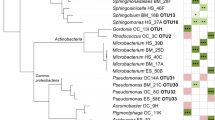Abstract
The aim of this study was to investigate permeation of the fungicide benomyl at its highest field application concentration (0.70 mg/mL) in Benlate 50 WP aqueous solution (1.4 mg/mL) through two types of unsupported and unlined nitrile gloves—a disposable latex glove (Safeskin) and an industrial chemical-resistant glove (Solvex)—using an American Society for Testing and Materials (ATSM)–type permeation cell with isopropanol collection medium. The permeation cell was contained in a moving-tray water bath at 30.0°C ± 0.5°C. The collection medium was evaporated and the residue derivatized with an optimized method (2,3,4,5,6-pentafluoro)benzyl bromide to form the disubstituted derivative of carbendazim (CARB), CARB.2PFB. The latter in isooctane was then quantified by gas chromatography–63Ni-electron capture detection (GC-ECD) by the internal standard method. GC-ECD, GC-mass spectrometry (GC-MS), and reflectance infrared investigations showed that little degradation of benomyl occurred in the challenge solution of aqueous Benlate during an 8-hour exposure period. Benomyl was collected as a mixture of CARB and benomyl as shown by the presence of a diagnostic chromatographic peak identified by GC-MS. The amounts permeated during the same time period were always higher for Safeskin than for Solvex gloves, with the latter being approximately 18 times more protective than the former after 8 hours of continuous exposure. Although the Solvex gloves were safe to wear at least for 4 hours and for almost 8 hours, the ASTM breakthrough threshold was used as reference and thus ignored carcinogenic effects. Reflectance infrared investigations detected benomyl and CARB on the glove challenge surface after drying and confirmed that the cleaned glove surfaces after permeation experiments did not differ in infrared reflectance spectra from the corresponding surfaces just before the permeation experiments.
Similar content being viewed by others
References
American Society for Testing and Materials (1996) Standard test method for resistance of protective clothing materials to permeation by liquids or gases under conditions of continuous contact. ASTM Method F739. American Society for Testing and Materials, West Coshohocken, PA
Bhat SA, Perenich T (1990) Soiling and effectiveness of various dosimeter materials in pesticide penetration/retention studies on selected textiles. Proceedings of the International Conference and of the American Association of Textile chemists and colorists, pp 29–33
Boogaard PJ, van der Waal H (1994) Biological monitoring of dermal exposure to 4,4’-diamino diphenylmethane (MDA) by determination of MDA in hydrolyzed urine—a human volunteer study. Shell Biomedical Laboratory, Preliminary Internal Report, Amsterdam, The Netherlands
Canning KM, McQuillan P, Jablonski W (1998) Laboratory simulation of splashes and spills of organophosphate insecticides on chemically protective gloves used in agriculture. Ann Agric Environ Med 5:155–167
Decoin M (2003) New, established and outgoing products. Protection of amenities, gardens and ornamental crops: What’s new over the past 12 months? Phytoma 561:32–37
Ehntholt DJ, Cerandolo DL, Bodek I, Schwope AD, Royer MD, Nielsen AP (1990) A test method for the evaluation of protective glove materials used in agricultural pesticide operations. Am Ind Hyg Assoc J 51:462–468
Forsberg K, Keith LH (1995) Chemical protective clothing. Lewis, Boca Raton, FL, p 108
Guo C, Stone J, Stahr HM, Shelley M (2001a) Monitoring granular Terbufos breakthrough: comparison of cotton gauze and alpha-cellulose. Bull Environ Contam Toxicol 60:553–556
Guo C, Stone J, Stahr HM, Shelley M (2001b) Effects of exposure time, material type, and granular pesticide on glove contamination. Arch Environ Contam Toxicol 41:529–536
Harville J, Que Hee SS (1989) Permeation of a 2,4-D isooctyl ester formulation through neoprene, nitrile, and tyvek protection materials. Am Ind Hyg Assoc J 50:438–446
Hazardous Substances Data Bank (2004) Benomyl. National Library of Medicine, TOXNET Data Base. Available at: http://www.toxnet.nlm.nih.gov/cgi-bin/sis/search (type in “benomyl”). Accessed: July 25 2005. Integrated Risk Information System (2005) Available at: http://www.toxnet.nlm.nih.gov/cgi-bin/sis/ (search under “benomyl” or “carbendazim”). Accessed: July 25 2005
Khan AA, Chen X, Que Hee SS (1997) Permeation of chlorpyrifos and endosulfan formulations through protective materials. Appl Occup Environ Hyg 12:413–417
Lin YW, Que Hee SS (1998a) Permeation of malathion through glove materials, Appl Occup Environ Hyg 13:158–165
Lin YW, Que Hee SS (1998b) Permeation of a malathion formulation through nitrile gloves. Appl Occup Environ Hyg 13:286–298
Lin YW, Que Hee SS (1998c) Permeation of a malathion formulation through butyl gloves. J Hazard Mater 60:143–158
Lin YW, Que Hee SS (1999) Glove permeation tests using novel microchemical techniques for 2,4-dichlorophenoxyacetic acid (2,4-D) derivatives. Arch Environ Contam Toxicol 36:485–489
Lu X, Que Hee SS (1998) Permeation of methomyl in lannate L through nitrile gloves. J Hazard Mater 59:279–285
McCarroll NE, Protzel A, Ioannou Y, Frank Stack HF, Jackson MA, Waters MD, et al. (2002) A survey of EPA/OPP and open literature on selected pesticide chemicals. III. Mutagenicity and carcinogenicity of benomyl and carbendazim. Mutat Res 512:1–35
Mikatavage M, Que Hee SS, Ayer HE (1984) Permeation of chlorinated aromatic compounds through viton and nitrile glove materials. Am Ind Hyg Assoc J 45:617–621
Moody RP, Ritter L (1990) Pesticide glove permeation analysis: Comparison of the ASTM F739 test method with an automated flow-through reverse-phase liquid chromatography procedure. Am Ind Hyg Assoc J 51:79–83
Moody RP, Nadeau B (1992) Effect of the mosquito repellant DEBT and long-wave ultraviolet radiation on permeation of the herbicide 2,4-D and the insecticide DDT in natural rubber gloves. Am Ind Hyg Assoc J 53:436–441
Moody RP, Nadeau B (1994) Nitrile butyl rabber glove permeation of pesticide formulations containing 2,4-D-amine, DDT, DEBT, and diazinon. Bull Environ Contam Toxicol 52:125–130
National Institute for Occupational Safety and Health (1977) Health and safety guide for pesticide formulators. Department of Health, Education, and Welfare, National Institute for Occupational Safety and Health Publication No. 77-100, Washington, DC
National Institute for Occupational Safety and Health (1978) Criteria for a recommended standard: Occupational exposure during the manufacture and formulation of pesticides. Department of Health, Education, and Welfare, National Institute for Occupational Safety and Health Publication No. 78-174, Washington, DC
Phalen R, Que Hee SS (2003) Permeation of captan through disposable rubber gloves. J Hazard Mater 100:95–107
Purdham JT, Menard BJ, Bozek PR, Sass-Kortsak AM (2001) MCPA permeation through protective gloves. Appl Occup Environ Hyg 16:961–966
Que Hee SS (1989) Permeation of some pesticidal formulations through glove materials. In: Perkins JL, Stull JO (eds) Chemical protective clothing performance in chemical emergency response. American Society for Testing ad Materials Publication No. OH-010370-55. American Society for Testing, and Materials, Philadelphia, PA, pp 157–164
Reisch M (2001) Benlate bites DuPont again; Jury convicts DuPont of hiding evidence; orders $78 million payment. Chem Eng News 79(34):14
Royal Society of Chemistry (1991) Benomyl. In: The agrochemicals handbook, 3rd ed. Royal Society of Chemistry, Cambridge, England, UK
Schwope AD, Goydan R, Ehntholt D, Frank U, Nielsen A (1992) Permeation resistance of glove materials to agricultural pesticides. Am Ind Hyg Assoc J 53:352–361
Silowski JR, Horstman SW, Morgan MS (1984) Permeation through five commercially available glove materials by two pentachlorophenol formulations. Am hid Hyg Assoc J 45:501–504
Singh RP, Brindle ID, Hall D, Chiba M (1990) Kinetic study of the decomposition of methyl [1-(butylcarbomoyl)-lH-benzimadazol-2-carbamate (benomyl) to methyl lH-benzimidazol-2-ylcarbamate (MBC). J Agric Food Chem 38:1758–1762
Singh RP, Chiba M (1993) Determination of benomyl audits degradation products by chromatographic methods in water, wettable powder formulations, and crops. J Chromatogr 643:249–260
Sittigul C, Pota S, Visitpanich J, Nualbunruang P, Sookchaoy K (2005) The brown spot disease of longan in Thailand. Acta Horticulturae 665:389–394
Tjan GH, Jansen JTA (1979) Gas-liquid chromatographic determination of thiabendazole and methyl 2-benzimidazole carbamate in fruits and crops. J Assoc Offic Anal Chem Int 62:769–773
United States Environmental Protection Agency US EPA (2002) Benomyl: tolerance revocations. Fed Regist 67:46900–46906
Valcke M, Chaveni F, Monge P, Bravo V, Mergler D, Partanen T, et al C (2005) Pesticide prioritization for a case-control study on childhood leukemia in Costa Rica: a simple stepwise approach. Environ Res 97:335–347
van Heemstra-Lequin EAH, Tordoir WF (eds) (1982) Education and safe handling in pesticide application. Elsevier, New York, NY
Watkinson AC, Brain KR, Walters KA, Hadgraft J (1993) Investigation, of relative rates of solvent and solute penetration through protective glove materials. Pesticide Sci 39:251–256
Wiesenthal K, Jehlar A, Que Hee SS (2000) Syntheses and HPLC/ultraviolet detection analysis of the O-(2,3,4,5,6-pentafluorobenzyl)hydroxylamine oximes of selected carbonyl compounds. J Assoc Offic Anal Chem Int 83:859–869
Wilschut A, ten Berge WF, Robinson PJ, McKone TE (1995) Estimating skin permeation. The validation of five mathematical skin permeation models. Chemosphere 30:1275–1296
World Health Organization (1993a) Benomyl. Environmental Health Criteria 148. World Health Organization, Geneva, Switzerland
World Health Organization (1993b) Carbendazim. Environmental Health Criteria 149. World Health Organization, Geneva, Switzerland
Zainal H, Que Hee SS (2003) Folpet permeation through nitrile gloves. Appl Occup Environ Hyg 18:658–668
Zweig G, Gao R.-Y. (1983) Determination of benomyl by reversed-phase liquid chromatography. Anal Chem 55:1448–1451
Acknowledgments
Funding for this study was provided by NIOSH/CDCP RO1 03754A and the University of California Los Angeles Center for Occupational and Environmental Health.
Author information
Authors and Affiliations
Corresponding author
Rights and permissions
About this article
Cite this article
Zainal, H., Hee, S.S.Q. Nitrile Glove Permeation of Benomyl. Arch Environ Contam Toxicol 50, 429–436 (2006). https://doi.org/10.1007/s00244-004-0189-7
Received:
Accepted:
Published:
Issue Date:
DOI: https://doi.org/10.1007/s00244-004-0189-7




